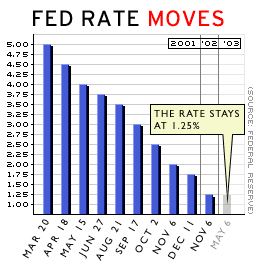NEW YORK (CNN/Money) -
As if prescribing chicken soup to a flu sufferer, most economists say another interest rate cut by the Federal Reserve "couldn't hurt" the U.S. economy, but some worry that such a cut could be toxic.
Policy makers at the Fed have raised expectations among investors that they'll cut short-term rates at their next meeting on June 24-25 by suggesting that while deflation is a remote threat, its evils are so grim that taking out a little "insurance" against it -- a term used recently by Fed Chairman Alan Greenspan -- couldn't hurt.

According to most economists, the only real danger of another rate cut, when the Fed's key short-term interest rate is already at its lowest level in 41 years, is that a little too much inflation might result, forcing the central bank to push rates back up a bit more quickly than it would have otherwise to cool off the economy and keep inflation in check.
"If the economy roars back, you can always take the cuts back," said Joshua Feinman, chief economist at Deutsche Bank Asset Management. "But suppose you're wrong on the other side, and the economy continues to languish? With the slack already in the markets, inflation is likely to move lower still."
The wrong medicine
While low inflation might sound like a good thing, it's bad if the trend can't be reversed. Corporate profits sink, leading to cost-cutting layoffs, weak demand, falling prices, more layoffs, and so forth. In short, it's a self-perpetuating cycle called deflation, and it can be ugly.
Most economists think another rate cut will support inflation by putting more money in people's hands, driving up spending and demand, which will boost prices.
But in a research note last month, and again in an interview in Sunday's New York Times, Merrill Lynch chief investment strategist Richard Bernstein argued a cut could actually let economic weakness linger, since the economy's problem has been too much supply, rather than a lack of demand.
| Related stories
|

|
|
|
|
What needs fixing, according to Bernstein and some economists, is not consumer demand, which has been surprisingly resilient, but corporate balance sheets. Only when companies trim down a glut of debt and unused equipment, the hangover from the 1990s investment orgy, will they be willing to spend again, according to this view.
Making credit increasingly easier only delays the painful restructuring necessary to get the economy healthy again, Bernstein believes -- making the United States look suspiciously similar to Japan, the world's second-largest economy, which has struggled for years to escape deflation.
"Policy makers seem to continue to believe that they can boost demand enough to alleviate the oversupply situation. They now talk of extraordinary monetary measures and huge tax cuts to stimulate demand," Bernstein wrote. "Although their timing was admittedly very poor, Japanese policy makers attempted the same thing."
Not-so-tiny bubbles?
Other economists worry Fed policy is only encouraging more 1990s-style speculation.
"Artificially low interest rates change people's speculative behavior in ways we may all come to regret," said James Grant, editor of Grant's Interest Rate Observer. "It's already incited a great burst of speculation in the bond market."
Sure enough, in the past two months -- during which the Fed has been "jawboning" about how it might be forced to use unconventional warfare to fight deflation, including driving long-term rates lower -- the yield on the 10-year Treasury note, already at extremely low levels, has plunged another 18 percent. The yield on the two-year note has fallen a whopping 31 percent, below the level of the Fed's key short-term rate.
Bond prices and yields move in opposite directions; the plunge in yields means bonds are extremely pricey right now, and some economists have grumbled they could be overinflated. A sudden drop in price could soak investors, and the coincident jump in interest rates and inflation might sucker-punch the economy.
Speaking of bubbles, other economists are worried that another flood of cheap, easy money could reinflate that relic of the 1990s, the stock-market bubble.
"I'm not worried about inflation per se; I'm worried about inflation in asset prices," said Sherry Cooper, chief economist at BMO Nesbitt Burns. "When the Fed has been aggressively easy in the past, it's ended up having to come in and aggressively raise interest rates and cause a lot of unnecessary dislocation."
That "unnecessary dislocation" could include another popping of another stock-market bubble, such as the one that occurred after the Fed started jacking up interest rates in 1999 and 2000 -- not a rosy time for stock investors, by any stretch.
Brian Wesbury, chief economist at the Chicago investment firm Griffin, Kubik Stephens and Thompson, pointed out several other possible negative repercussions of ever-lower rates, including;
- lower returns for lenders
- lower purchasing power for people on fixed incomes
- lower earnings power for insurance portfolios, putting upward pressure on insurance premiums
"By cutting interest rates too far...the Fed is using the monetary equivalent of a corked bat," Wesbury said. "The end result will be more damage from lower rates, more volatility in future interest rates and more confusion about what monetary policy can and cannot do."

|

